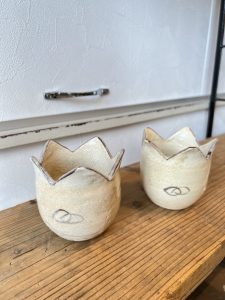本日は志野焼について。(愛知県名古屋市千種区姫池通 骨董買取 古美術風光舎)
2024.03.31
みなさまこんには、スタッフYでございます。
このところ来週4月5,6,7日店舗にて開催されます「器と骨董展」にむけて、器についてのお勉強中なのですが、ちょうど面白い志野焼の桔梗型の向付が目につきました。お茶のお稽古をされている方ですとご存知かと思いますが、本日はその「志野焼」についてつぶやいていきたいと思います。

志野焼は美濃焼の一種なのですが、それにしても私がイメージするのは抹茶茶碗でして。美濃(岐阜県)にて安土桃山時代に焼かれた白釉を使った焼物なのですが、赤志野や鼠志野などいくつかの種類があり、同じく美濃焼の一種である瀬戸黒とともにその技法は重要無形文化財に指定されているものや、岐阜県の重要無形文化財に指定されているものなどがあります。
室町時代の茶人・志野宗信が美濃の陶工に命じて作らせたのが始まりとされ、可児市久々利から土岐市泉町久尻にかけて産出する耐火温度が高く焼き締りが少ない五斗蒔粘土やもぐさ土という鉄分の少ないやや紫色やピンク色がかった白土を使った素地に、志野釉(長石釉)と呼ばれる長石を砕いて精製した白釉を厚めにかけ焼かれます。通常、釉肌には肌理(きめ)の細かい貫入や柚肌、また小さな孔が多くあり、釉のかかりの少ない釉際や口縁には、緋色の火色と呼ばれる赤みのある景色が出ることのですが、これらさまざまな偶然が重なることで志野焼の面白さ、そして奥ゆかしさの表現をいっそう広げているように思えます。
数年前なのですが、日本を代表する国宝の志野茶碗「銘卯花墻」(うのはながき)をタイミングよく拝見することがありました。日本で焼かれた茶碗で国宝に指定されているのは、本阿弥光悦の白楽茶碗(銘不二山)と、この卯花墻の2碗のみなので、絶対に見逃していけない。と、気合を入れて(笑)三井美術館へ乗り込んでいったことがとても記憶に残っております。
拝見したままの様子はといいますと、素地は卵殻色の俗に言う百草土。白濁半透性のいわゆる志野釉が厚くかかり、口辺その他施釉の薄い部分は赤くこげ、全面に荒い貫入があり、底裏無釉、轆轤による成形。これを歪ませ、また篦を入れ、底付近には陶工の指跡も生々しく残っている様子でありました。また、釉下に鉄絵具で奔放な縦横の筋をいれてありますが、銘印ありません。
美濃で焼かれた志野焼は、日本陶磁史上はじめて下絵付で絵を描いた陶器でして、「銘卯花墻」にも簡略な格子状の線が引かれているのですが、江戸時代前期の武将茶人・片桐石州は、その文様の白い釉薬で見え隠れするさまを卯の花が咲く垣根に見立て、「卯花墻」と名付けたのがその名の由来のようでして、自分が拝見した時にもとても小ぶりなお茶碗だな…と、最初に思いました。奥ゆかしい趣のお茶碗という印象でした。その肌に垣根に見え隠れする卯の花が見えてくるような見えてこないような…なのですが、景色をどうとらえるかは本人の想像力によるも。覗き込みながらその無限に広がる想像力をかきたてる奥ゆかしい小さなお茶碗でした。
そんなわけでこの桔梗型の向付とも対峙してみるのですが。自分には「消えかかった春の霞」でしょうか…。上手く表現できませんが、別の人にその見立てを尋ねてみるのも焼物の鑑賞の面白い遊びかもしれませんね。みなさまは何に見立てますか?
それではごきげんよう。
Hello everyone, this is Staff Y.
I have been writing a blog about the “Vessels and Antiques Exhibition” that will be held at our store on April 5, 6, and 7, and I noticed an interesting Shino ware with a Kikyo (bellflower) shape. I have just noticed an interesting Shino ware with a Kikyo-shaped motif, which I think those of you who practice tea ceremony may be familiar with.
Shino ware is a type of Mino ware, but what I imagine it to be is a green tea bowl. It is a pottery using white glaze fired in Mino (Gifu Prefecture) in the Azuchi-Momoyama period, but there are several types such as red Shino and rat Shino, and the technique is designated as an important intangible cultural property along with Setoguro, which is also a type of Mino ware, and also designated as an important intangible cultural property of Gifu Prefecture.
It is said that the tea ceremony master of the Muromachi period, Munenobu Shino, ordered potters in Mino to produce this pottery, and it is said that the origin of this pottery is the Goto-maki clay, which is produced from Kuri, Kani City to Kusiri, Izumi Town, Toki City, and has a high refractory temperature and low firing retardancy, and mogusa clay, a slightly purple or pinkish white clay with low iron content. The glaze is then applied thickly and fired. Usually, the glaze surface has fine texture and many small pores, and the edges of the glaze and mouth rim, where the glaze is less applied, have a reddish appearance called scarlet fire color. It was a few years ago.
A few years ago, I had a chance to see a Shino tea bowl “Mei Unohanagaki,” a national treasure representing Japan, at the right time. Since there are only two tea bowls made in Japan that are designated as National Treasures, Hon’ami Koetsu’s Shiraku tea bowl (inscribed Fujisan) and this Unohanagaki, I was determined not to miss it. I remember that I went to the Mitsui Museum of Art with a lot of enthusiasm (laugh).
As I looked at them, they were made of eggshell-colored clay, commonly known as “Hyakuso-do”. The white, semi-transparent Shino glaze was applied thickly, the mouth and other thinly glazed areas were reddish brown, and the entire surface was roughly pierced. The bottom back was unglazed, and the potter’s wheel was used to mold it. The potter’s finger marks were clearly visible near the bottom of the potter’s wheel, which had been warped and hollowed out. There is no mark on the bottom of the bowl.
Shino ware, which was fired in Mino, was the first pottery in the history of Japanese ceramics to be painted with underglaze enameling, and “Ming Ubana-mamen” also has simple lattice-like lines drawn on it. When I saw it, I thought it was a very small tea bowl…. I had an impression that it was a tea bowl with a profoundly elegant taste. I could almost see the rabbit flowers that were hidden in the hedge on its skin…but how you perceive the scenery depends on your own imagination. It was a profoundly small teacup that stirred the infinite imagination of the person peering into it.
So I confronted this Kikoko-shaped mukozuke. For me, it is like a “fading spring haze”…. I can’t express it well, but it might be an interesting game of pottery appreciation to ask another person to describe it.
Have a good day.
*******************
ご実家の整理やお片付けなどをされている方のご相談などが多くございます。
お片付けなどくれぐれもご無理のないようになさってくださいませ。
風光舎では古美術品や骨董品の他にも絵画や宝石、趣味のお品など様々なジャンルのものを買受しております。
お片付けをされていて、こういうものでもいいのかしらと迷われているものでも、どうぞお気軽にご相談下さいませ。
また風光舎は、出張買取も強化しております。ご近所はもちろん、愛知県内、岐阜県、三重県その他の県へも出張いたします。
まずは、お電話お待ちしております。
愛知県名古屋市千種区姫池通
骨董 買取【古美術 風光舎 名古屋店】
TEL052(734)8444
10:00-18:00 OPEN

